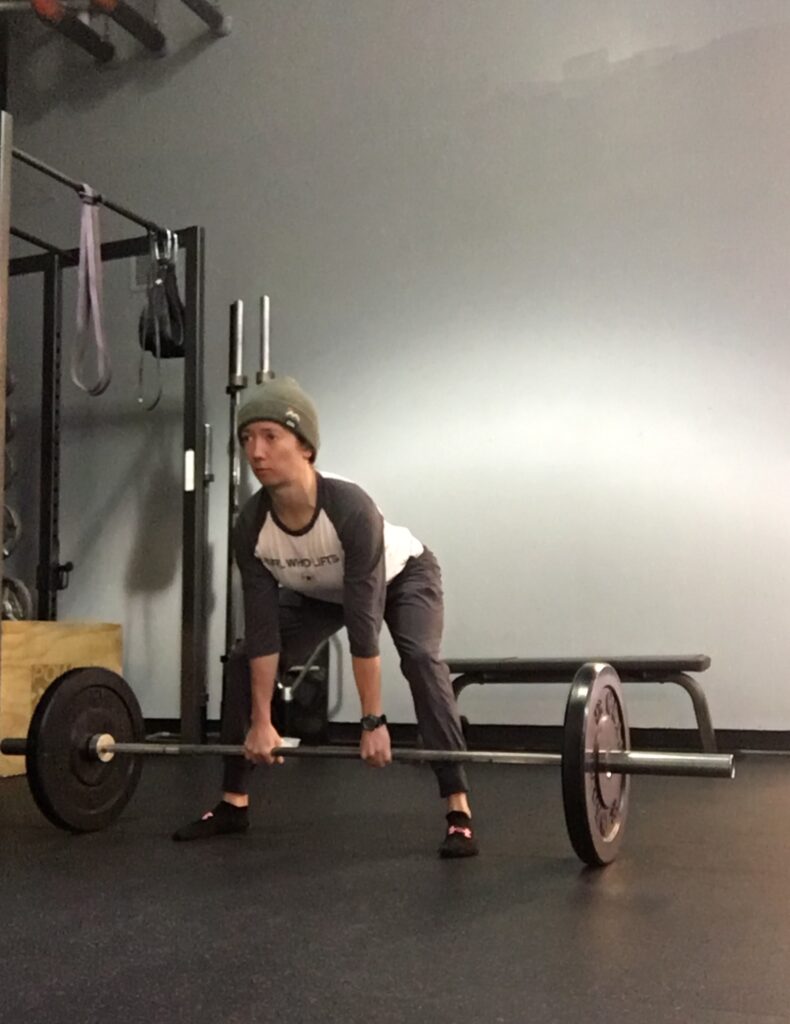There’s nothing quite so satisfying as picking up a crazy-heavy barbell off the floor, amiright?
The deadlift is an incredible full-body exercise that improves grip strength, challenges every muscle in your posterior chain, enhances athleticism, and builds a bigger booty. Learning to properly hip hinge and working up to heavy* deadlifting can do wonders for your physique, athletic performance, and overall awesome-ness.
(*When I say “heavy,” keep in mind, I mean that relative to YOU. Not everyone wants or needs to rip +400# off the floor.)
The deadlift is the solution to many fitness goals:
- So you want to lean out? Nothing activates more muscles, and thus burns more calories, than the deadlift.
- Want to get ridiculously strong? Again, nothing activates more muscles, delivering massive bang-for-your-buck strength gains.
- Want to become a better athlete? The deadlift will unlock the power of your hips, which drive all athletic movement.
- Want to build a bigger backside? You guessed it… deadlift (and hip thrust, while you’re at it).
To say I have a love affair with the deadlift is an understatement. But I won’t bore you with any more details of my love for the deadlift. Instead, I want to teach you how NOT to fck up this fantastic exercise.
You see, the deadlift is probably the most-often butchered exercise I see in the gym… second only to the kettlebell swing, which is essentially a more dynamic version of a deadlift.
Why do people mess up deadlifts so badly? I don’t have science to back this up, but my best guess is that modern living has untrained our bodies from hip hinging. This basic movement pattern (the hinge) is underutilized in our daily lives, so we “forget” how to move our hips and use our glutes to power our movement. Blame sitting. Spending all day sitting on your butt essentially turns off your glute muscles, which should be the strongest muscles in your body. That’s why the deadlift is so incredible – it unlocks your tight hips and powers up your glutes so they can do their job.
There are a lot of myths out there that deadlifting will hurt your back. The truth is, deadlifting is amazing for all the reasons I mentioned above but deadlifting (or doing any other exercise) incorrectly can lead to injury. The exercises themselves are not dangerous, but lifting with bad technique is.
This article will teach you to fix the most common deadlifting mistakes so you lift safely and reap all the benefits of the deadlift.
Deadlift Pre-Requisites
First things, first. The deadlift requires mobility through the posterior chain (that’s your backside, so butt, hips, and hamstrings) and stability through the trunk (encompassing both your abs and your back). You should master unloaded hip hinging and learn how to brace your abdominals before learning to deadlift.
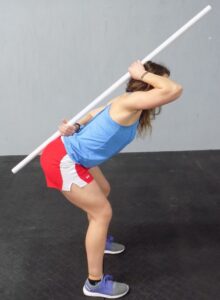
The best drill for this is grabbing a PVC pipe, broom handle, or other stick-like object and using it for feedback on your hinge. Hold the PVC behind your body, with one hand on your head and one on your tailbone. Initiate the hinge from your hips. We’re looking for straight legs with a soft knee bend, hips pushed back, a flat torso with abs engaged, and chin tucked. If the PVC comes off your body at any point, you’ll immediately know you’ve lost position.
When you can reliably execute the PVC hinge, move on to kettlebell deadlifts to load the movement and groove your technique. Be sure to brace your core as the kettlebell weight increases; imagine some (jerk) is about to punch you in the gut, so your abdominals tense to protect your body. Build up the amount of weight you use with bells until you’re ready to advance to the barbell deadlift.
Deadlift Set Up
There are two pulling styles: the conventional deadlift and the sumo deadlift. Each have a different set up. One isn’t better than the other, they’re just different ways of moving a weight from point A to point B.
In the conventional deadlift, you stand with your feet hip-width apart and place your hands just outside of your legs.
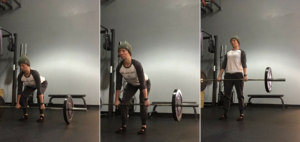
The sumo deadlift uses a wider stance (mine is pretty narrow due to my hip anatomy). Turn your toes outward and place your hands inside your legs as you grip the bar.
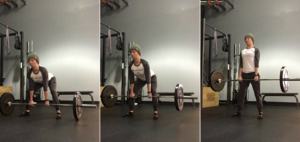
Play around with the conventional and sumo variations and decide which pulling style feels “right” for you. Again, there’s not a better/worse variation. Only what works for your body.
Common Deadlifting Mistakes… And How To Avoid Them
Again, the deadlift isn’t dangerous, but lifting with poor form can be. Here’s how to fix the most common deadlifting mistakes so you reap all the benefits of the deadlift, get really ridiculously strong, and avoid injuries.
Deadlifting Mistake #1: Squatting
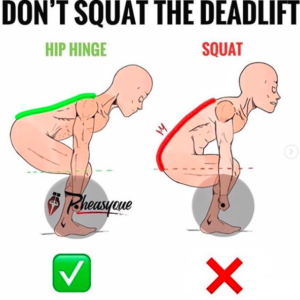
The first HUGE mistake people make when deadlifting is turning it into a squat. The deadlift is a hip hinge, not a squat. Hip hinging literally means “hinging from the hips,” so you shouldn’t move through your knees as you do when squatting or lunging.
Note: Your knees will move a little as you lockout the lift, but it’s a hip-dominant movement, not a knee-dominant one like the squat.
So make sure you’re hinging from your hips instead of squatting down to pick up the bar.
The best way to accomplish this is to think about reaching for the wall behind you. Better yet, set yourself up in front of a wall and physically touch your butt to the wall with each deadlift repetition. You can use the good old PVC to practice this if your gym’s layout won’t allow for deadlifting next to a wall.
Deadlifting Mistake #2 – Failing To Maintain A Neutral Spine
You’ve probably heard the advice to “lift with your legs, not your back” when moving heavy furniture. That’s solid deadlift advice that many people either don’t know or straight up ignore. What happens often is people aren’t creating enough tension or bracing their abdominals hard enough, so their backs round.
Rounding your back during the deadlift is a big no-no. You want to maintain a neutral spine (flat back) throughout the lift.
Instead of thinking about picking up the bar and letting your back do the work, use your legs to push through the floor like you’re trying to push it away from you. This will force your legs to do the work they’re supposed to do. If you feel anything in your low back, you’re probably rounding out.
Your legs aren’t the only muscle group at work in the deadlift, not by a long shot. Deadlifting heavy shyt requires full-body tension generated by bracing your core, which includes your abs and back muscles.
If you can’t create this full-body tension, you’ll round your back and potentially cause lower back pain. To deadlift safely, you must learn to brace your abs and engage your lats so that your back remains flat throughout the lift, from set up to lockout.
As you set up to deadlift, follow this process: First brace your abs hard, tightening your entire mid-section as though it’s a corset. Then hinge to grip the bar, and engage your lats by pulling your shoulders down and back.
Once you’re set up, you might think you’re good to go, but there’s one more important step before you actually lift the weight. That’s where the next tip comes in.
Deadlifting Mistake #3 – Yanking The Bar Off The Ground
Many people hinge to lift the barbell, then yank it off the ground. This results in rounding their backs, which we already determined is not ideal.
Instead, you must “take the slack out” of the barbell before you lift it. Do this by gently lifting up on the bar until you feel resistance. Note that you’re not trying to lift the bar off the floor yet – you’re just pulling out the slack.
Any slack in the system is like a “leak” that wastes energy, similar to a leaky faucet wasting water. You’ll need to generate more force to lift the bar if you don’t pull out the slack first… and most of that force is gonna go straight to your lower back.
Pull the slack out of the bar! Then lift it. Your back will thank me.
Deadlifting Mistake #4 – Letting Your Shoulders Round
When you get set up and take the slack out of the bar, you do this by engaging your lats, which pull your shoulders down and back. Oftentimes, people fail to maintain their lat and upper back engagement as they pull, which results in rounded shoulders (and probably a rounded spine).
To correct this, think “chest up” or “proud chest.” Someone should be able to read the logo off your T-shirt while you’re deadlifting.
Deadlifting Mistake #5 – Butchering The Lockout
We’ve talked about your set up, the start of your pull, and how important it is to maintain core and back engagement throughout the deadlift. Let’s fix your “lockout” position next.
The lockout of the deadlift is when you’ve successfully picked the bar up from the ground and hit full hip extension by standing tall. You should be in a “stacked” position when viewed from the side – feet, knees, hips, shoulders, and head all stacked in a straight, vertical line.
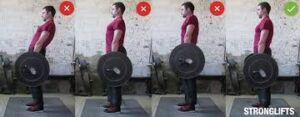 The mistake many people make is not pushing their hips all the way through, or overcompensating by arching backwards.
The mistake many people make is not pushing their hips all the way through, or overcompensating by arching backwards.
To correct this, squeeze your butt like you’re trying to crack a walnut between your cheeks. Your glutes are responsible for hip extension, so squeezing them will ensure your hips come through. And when you engage your glutes to extend your hips, your lower back doesn’t need to arch to reach that tall lockout position.
Deadlifting Mistake #6 – Performing A Million Repetitions
Look, I don’t care what people tell you about using low weights and high reps to “tone” your muscles… the deadlift is NOT a toning exercise. It’s a strength exercise.
If you want to isolate your hamstrings, do hamstring curls. If you want to build a stronger body, deadlift.
(Psst… if you want to get stronger, I’ve got a guide to help you with that. Click here to download it for free.)
Keep your deadlift volume to three to five sets of 1-8 repetitions (1-3 for pure power, then 3-8 enters into the strength/muscle ballpark, which is a good place to be if you want to tone up, by the way). And use heavy weights! That’s how you build strength.
Deadlifting Mistake #7 – Thinking You Have To Pull From The Floor
Look, I opened this article by saying, “There’s nothing quite so satisfying as picking up a crazy-heavy barbell off the floor, amiright?”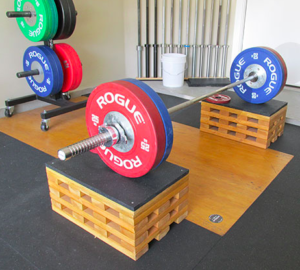
And I firmly believe that it’s the funnest thing you can do in the gym. But I don’t mean to imply that everyone has to deadlift from the floor.
The fact is, many people lack the mobility necessary to get into the proper position to deadlift from the ground.
And that’s okay. There are a million deadlift variations that are better suited to you if your mobility is holding you back from pulling from the ground.
Your best bet is to try rack or block pulls, which involve using a squat rack with adjustable pins or blocks/boxes to elevate the bar off the gym floor. Check out the shameless Rogue promo pic to the right to get an idea for a block pull set up.
Elevating the bar obviously reduces the distance you have to cover when you hinge, making it the best way to deadlift with limited mobility. You can stack a couple plates on the floor to elevate the bar if your gym doesn’t have two plyo boxes of matching height.
Deadlifting Mistake #7.5 – Thinking You Have To Barbell Deadlift
Just as you don’t “have to” pull from the floor, you don’t have to deadlift a barbell.
Dumbbell Romanian deadlifts are awesome, as are single- and double-kettlebell deadlifts.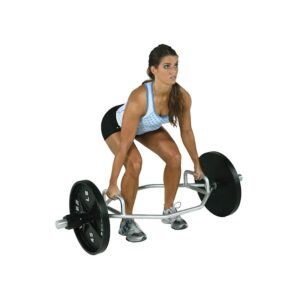
What makes a “Romanian” deadlift Romanian? No idea. But the difference between RDL’s and pulling from the floor is that you start from the lockout position, then lower the weight to about knee or mid-shin height, as dictated by your own unique mobility and ability to maintain a flat back.
There is also a specialty barbell called a “trap” or “hex” bar that makes a great starting point for people learning to deadlift. Check out the overly-make-upped lady using the hex bar in the pic to the right. Doesn’t she look like she’s having fun?
What’s cool about the hex bar is that you stand inside of it with the weights directly to your side. Having yourself at the center of this contraption makes it a lot easier to keep a neutral spine. The hex bar deadlift is where I start many of the athletes I work with in the gym.
Frequently Asked Deadlifting Questions
There are a lot of other questions that I frankly wasn’t sure how to cover under the umbrella of “mistakes,” so I just wanted to address a couple more points in a quick FAQ section to clear up anything else you might be wondering about the deadlift.
What’s better, overhand or mixed grip? You might see people deadlifting with one hand over the bar and one flipped underhand. That’s called a “mixed grip,” and it can help you lift heavier weights than your grip strength would normally allow by preventing the bar from slipping out of your hands. The mixed grip is fine, but it has the potential to mess up your bicep tendon on the underhand side. Either switch your mixed grip if you have to use it, or train double-overhand as much as possible when you’re not going for a max-effort lift. This has the added bonus of building your grip strength, so why not improve that while you’re at it.
Will deadlifting make me more awesome? Yes. Deadlifting is scientifically proven to increase your awesome-ness by at least 50% guaranteed.
Can you help me get better at deadlifting? Why, yes, I can. If you’re interested in getting strong at the deadlift (and other exercises, too) just fill out a coaching application here, and I’ll be in touch.
I like working with cool people, though, so as long as you’re into dogs, the great outdoors, craft beer, Cleveland sports, and/or loud, guitar-driven music, we’re good to go. If not… well, there’s nothing I can do for you 🙂

